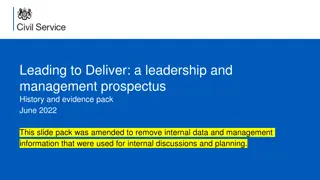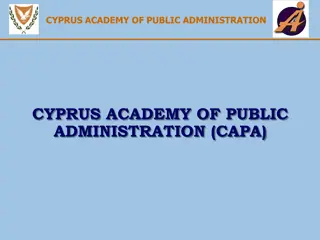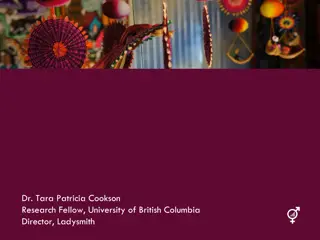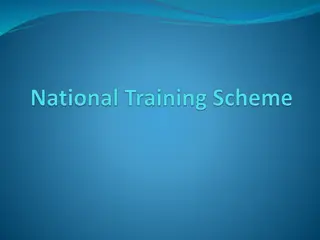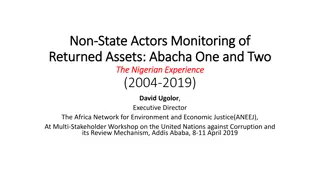Civil Society Training on Public Finance Management for Social Protection
Public Finance Management involves mobilizing revenue, allocating funds, and undertaking public spending efficiently and transparently to achieve satisfactory social outcomes. Civil society and trade union advocates play a crucial role in integrating social protection into the PFM process to realize national economic and social goals. The training session aims to explore the basic concepts of PFM, strengthen social protection systems, and universalize social protection regimes in participating countries.
Download Presentation

Please find below an Image/Link to download the presentation.
The content on the website is provided AS IS for your information and personal use only. It may not be sold, licensed, or shared on other websites without obtaining consent from the author. Download presentation by click this link. If you encounter any issues during the download, it is possible that the publisher has removed the file from their server.
E N D
Presentation Transcript
Civil Society Training on Public Finance Management for Social Protection Global Coalition for Social Protection Floors This Civil Society Training Manual on Public Financial Management for Social Protection is part of the Programme Improving synergies between Social Protection and Public Finance Management", funded by the European Union. This document was produced with the financial assistance of the European Union. The views expressed herein can in no way be taken to reflect the official opinion of the European Union. 1
WHAT IS PUBLIC FINANCE MANAGEMENT (PFM)? Public Finance Management is a process of Mobilizing revenue, Allocating funds, Undertaking public spending efficiently, effectively, transparently, and with equity. The aim, from a civil society perspective, is to deliver satisfactory social outcomes for the well-being of people. 7/31/2024 GCSPF-1 2
Civil Society and Trade Union Advocates Have A Crucial Role to Play They must ensure that social protection is well integrated into the PFM process. 7/31/2024 GCSPF-1 3
Crucial Role of Civil Society and Trade Union Advocates They must remind their governments that social protection is central to the realization of important national economic and social goals: economic growth, sustainable development, decent livelihoods and wellbeing for national populations. 7/31/2024 GCSPF-1 4
Purpose of the Training Session To explore the basic concepts, processes and tools that underpin public finance management. Through presentations and interactive discussion, to demonstrate their relevance for the strengthening of social protection systems, and for the progressive universalizing of social protection regimes. Training sessions will be conducted virtually, at country level, in the four participating countries of the GCSPF EU- DEVCO project: Improving Synergies between Social Protection and Public Finance Management, namely: Cambodia, Nepal, Senegal, and Uganda. 7/31/2024 GCSPF-1 5
Main Components of the Training Session Introduction to resource materials, Illustrative examples of relevant country experiences, Guide questions, Accompanying glossary of terms. All are meant to inform and to stimulate highly interactive discussions in which participants will share relevant experiences and learn from each other and from facilitators. 7/31/2024 GCSPF-1 6
Desired Outcomes At the end of the session, CSO/TU advocates and activists will be better equipped to engage with their governments and institutional partners. The aim is to develop capacity for effective participation in dialogues on the building and strengthening of social protection regimes, on sustainably financing them, and on monitoring for desired results, all with a PFM lens. 7/31/2024 GCSPF-1 7
The PFM Process PFM can be conceived as a process in six phases. These correspond, essentially to the six phases of the annual budget cycle. Note, however, that the full PFM cycle typically goes beyond the annual budgetary cycle, and is more often a multi-year process. 7/31/2024 GCSPF-1 8
The PFM Process The Government Budget Cycle-Figure 1 7/31/2024 GCSPF-1 9
The PFM Process The Government Budget Cycle-contd. 7/31/2024 GCSPF-1 10
The PFM Process The Government Budget Cycle-contd. 7/31/2024 GCSPF-1 11
Multi-stakeholder Dialogue and the Annual Budget Cycle An important point to note: The budget cycle, as outlined in Figure 1, makes provision for multi-stakeholder dialogue and participation as a cross-cutting activity, relevant to every phase. The degree to which this goal is realized may depend upon the civic space available in any given country. 7/31/2024 GCSPF-1 12
PFM Principles make provision for multi-stakeholder dialogue Provision for multi-stake holder dialogue is consistent with the following PFM principles: Budget documents and data should be public, transparent and accessible. The budget cycle should follow due process, applying checks and balances as an accountability mechanism. Debate on budgetary choices should be inclusive, participative and realistic. (Refer to slides 44-46 for 9 PFM principles). 7/31/2024 GCSPF-1 13
Review of the Budget Cycle [Refer to Figure 1] Phase 1. The Office of the President/Prime Minister supported by the Ministry of Finance (MOF) typically leads the Phase 1 policy formulation activities. Guiding documents on sustainable development, economic and social strategies may be assembled and discussed, harmonized and prioritized. 7/31/2024 GCSPF-1 14
Review of the Budget Cycle contd. The aim at this stage is to arrive at a common vision for: the national development strategy, the medium-term expenditure strategy, and the annual budgetary process. 7/31/2024 GCSPF-1 15
How can CSOs/Trade unions engage in Phase 1 of the budget cycle? An instructive example comes from Uganda: The Government of Uganda is currently reflecting on whether the country should be establishing a Social Protection Floor. 7/31/2024 GCSPF-1 16
CSO/Trade union engagement in Phase 1 of the budget cycle contd. The subject of a social protection floor is very relevant to Phase 1 of a future budget cycle: Policy Formulation towards a National Development Strategy . The current EU-DEVCO GCSPF Project is committed to supporting CSO/trade union participation in national dialogues aimed at defining a vision for a social protection floor. 7/31/2024 GCSPF-1 17
Phase 1 of the Budget Cycle. Topic for Discussion Has your CSO/Trade union network been engaged in policy dialogues with your government on defining a vision and broad goals for universalizing social protection, such as through establishing/strength ening a social protection floor? 7/31/2024 GCSPF-1 18
Review of the Budget Cycle contd. Phase 2. [Refer to Figure 1] At the second phase, sector ministries set their priorities and submit their plans and annual budgets. A large number of actors engage in the budgetary cycle at this stage, in so far as policy space and procedural practice allow. The aim of these actors is to ensure that the process operates effectively and transparently while maintaining accountability (all important PFM principles), and that it incorporates important societal priorities from their perspective. 7/31/2024 GCSPF-1 19
Illustration of Phases 1 and 2 of the Budget cycle: The Project Documents for Nepal and Senegal discuss the importance of promoting shock- responsive approaches to social protection. The aim is to ensure adequate and predictable funding for services to affected populations in times of crisis. 7/31/2024 GCSPF-1 20
Shock-responsive approaches to Social Protection contd. These activities in Nepal and Senegal illustrate what is involved in Phases 1 and 2 of the budget cycle: Policy formulation, and elaboration of sectoral budgets. In Nepal, the focus has been on natural disasters, and a workshop was organized by UNICEF on this topic at the inception phase of the EU-DEVCO/GCSPF project, in which CSOs participated. In Senegal, the focus has been on the crisis of food insecurity, and the need to address this through social protection programmes. 7/31/2024 GCSPF-1 21
Applying shock-responsive approaches to the Covid-19 crisis The Covid-19 crisis has served to highlight the need to incorporate shock-responsive approaches to social protection from the outset, that is, at the policy- formulation phase of the budget cycle (Phase 1). Shock-responsive systems should have a strong answer to how to fund the accompanying programmes, so they could effectively incorporate adaptive mechanisms to cater to the needs of those experiencing vulnerability, such as expanding food banks to address food insecurity, or mobilizing emergency funds for expanded cash transfer programs. 7/31/2024 GCSPF-1 22
Guide topic and questions on shock- responsive approaches to social protection CSOs/trade unions may wish to seek opportunities to discuss with their government, the latter's perspectives on shock-responsive social protection. Has your network had any dialogues with the government or institutional partners (UNICEF, ILO, the IMF country mission), on the question of shock- responsive social protection? What shocks should the government prepare for? What services should it offer in response to a shock? Does it have or need to develop the administrative and financial capacity to respond appropriately? 7/31/2024 GCSPF-1 23
Review of the Budget Cycle contd. Phase 3 [Refer to Figure 1] At the third phase of the budget cycle, the budget authority allocates annual allotments to government departments, agencies, and possibly to sub-national authorities. Through an iterative process, they reach agreement on a national budget, broken down in different ways: by programme sector, ministry operations, contributions to sub-national level, line by line. 7/31/2024 GCSPF-1 24
Critical need for advocacy at Phases 2 and 3 of the Budget cycle Phases 2 and 3 of the budget cycle are critical for CSO/Trade union advocates. They should seek opportunities to advocate for increased allocations to underfunded areas in social protection budgets, with a view to meeting the critical needs of vulnerable populations, They should advocate for the progressive extension of coverage under the nine contingencies of social security. 7/31/2024 GCSPF-1 25
The Nine Contingencies of Social Security References: The Social Security (Minimum Standards) Convention 102 of the International Labour Organization (ILO, 1952), and the Maintenance of Social Security Rights Convention 157, (ILO, 1982). These Conventions provide a framework for pursuing comprehensive social security and social protection coverage by identifying nine contingencies over the life course, requiring provision of benefits to the affected citizens of a country. 7/31/2024 GCSPF-1 26
The Nine Contingencies of Social Security contd. Governments should ensure the following provisions: 1) medical care, 2) sickness benefits, 3) unemployment benefits, 4) old-age benefits, 5) employment injury benefits, 6) family/child benefits, 7) maternity benefits, 8) invalidity/disability benefits and 9) survivors benefits 7/31/2024 GCSPF-1 27
Guide question on Phases 2 and 3 of the budget cycle Phases 2 and 3 deal with budget elaboration and budget allocation. Has your CS/TU network engaged with relevant sector ministries concerning your priorities with regard to issues such as: design, coverage in relation to the nine contingencies of social security, and funding of social protection programmes. 7/31/2024 GCSPF-1 28
Review of the Budget Cycle contd. [Refer to Figure 1] Phase 4. During this phase, the budget is approved after parliamentary debate and possible revision. Phase 5. At this stage allocations are made, and programmes are implemented. Phase 6. During this phase, programmes are evaluated for their performance in relation to goals and targets. 7/31/2024 GCSPF-1 29
Illustration of Phases 5 and 6 of the Budget cycle: Implementation, and Monitoring & Evaluation The Nepal EU-DEVCO/GCSPF Project document reports that research has revealed many coverage gaps and exclusion errors in the delivery of social protection. These anomalies affect, most notably, benefits to persons with disabilities (PWDs), and child grants. The present Project plans to focus on support to the Government of Nepal in "strengthening the system of service delivery in order to overcome these challenges. 7/31/2024 GCSPF-1 30
Illustration of Phases 5 and 6 of the Budget cycle contd. Support initiatives (of the EU-DEVCO project) will focus on: identification of beneficiaries, registration, payment, monitoring and reporting. The aim is to expand coverage and reduce exclusion errors, focusing also on improving the registration process, timely payment and real time monitoring of the child grant and the disability grant. 7/31/2024 GCSPF-1 31
Illustration of CSO/TU Entry points into Phases 5 and 6 of the Budget cycle Working alongside UNICEF and ILO to realize the project objectives (of the current EU-DEVCO project) could provide the CSO/Trade union network with entry points into discussions with the government in phases 5 and 6 of the PFM cycle, Implementation, and Monitoring & Evaluation. 7/31/2024 GCSPF-1 32
Illustration of CSO/TU Entry point into Phase 5 of the Budget cycle Included in Implementation are grievance- handling/redress mechanisms which are reportedly weak, and thus in need of strengthening. CSOs/trade unions could advocate for strengthened grievance/redress mechanisms. CSOs/TUs could use these mechanisms to support workers, families, vulnerable populations and other target groups within communities, to assess the coverage and quality of service delivery, and to bring issues for redress to the attention of the relevant agencies and service providers. 7/31/2024 GCSPF-1 33
Illustration of CSO/TU Entry point into Phase 6 of the Budget cycle The Project Document for Senegal reports that UNICEF has supported the Ministry of Economic Planning and Cooperation in the creation of the Social Budget Monitoring Observatory (OSBS). This activity is relevant to Phase 6, Monitoring and Evaluation. The aim is to generate the evidence needed to advocate for an increased budget to the social sector, thus, also providing a feed- back loop to Phase 2, elaboration of sectoral budgets, for a subsequent budget cycle. CSOs/Trade unions may wish to utilize existing monitoring mechanisms such a the OSBS to generate their own evidence for avocacy on financing of priority areas in social potection. 7/31/2024 GCSPF-1 34
Guide questions on Phases 5 and 6 of the Budget cycle Has your CS/TU network engaged in monitoring of implementation of social protection programmes, for example regarding: adequacy of coverage, exclusion errors in registration, grievances among recipients and use of redress mechanisms? [Refer to the experience of Nepal]. 7/31/2024 GCSPF-1 35
Guide question on Phase 6 of the Budget cycle Do monitoring mechanisms exist for tracking beneficiaries' access to programmes and services in specific sectors? If yes, do your network members make use of them to assess quality and adequacy of service delivery, and to generate the evidence base for advocacy on social protection? [Refer to the experience of Senegal]. 7/31/2024 GCSPF-1 36
Achieving fiscal space to maintain and scale up social protection programmes Fiscal space has been defined by the IMF as the availability of budgetary room that allows a government to provide resources for the desired purpose without any prejudice to the sustainability of a government s financial position. Expanding fiscal space for social protection is essentially about finding opportunities to mobilize additional revenue and to allocate additional funds to social protection expenditure. 7/31/2024 GCSPF-1 37
Understanding the concept of expanding fiscal space It is important for CSOs/TUs to understand the concept of expanding fiscal space . It is key to their advocacy strategies for increased financing of social protection. In this regard, they must develop the arguments to back their calls for governments to fulfill their human rights obligations and their commitment to achieve the Sustainable Development Goals(SDGs). 7/31/2024 GCSPF-1 38
Expanding fiscal space the antidote to fiscal consolidation CSOs/TUs must insist that their governments make every effort to ensure that social protection programmes are maintained, despite economic downturns in times of crisis. Governments should not cut back on pre- planned social protection expenditure in the name of austerity or fiscal consolidation. Rather, they should explore options for expanding fiscal space. 7/31/2024 GCSPF-1 39
What is Fiscal Consolidation? Fiscal Consolidation refers to the set of austerity measures used by many governments to reduce budget deficits following times of crisis (economic downturns, natural disasters, public health crises such as the COVID-19 pandemic). Primarily, it involves cuts in public expenditure, in particular social expenditure (health, education, the wage bill, social protection). [Refer to the definition of fiscal consolidation in the accompanying Glossary of Terms]. 7/31/2024 GCSPF-1 40
Illustration of CSO/TU engagement in initiatives to expand fiscal space The CSO/trade union network in Cambodia plans to engage in dialogue with relevant government bodies to explore the question of expanding fiscal space for increased social protection coverage for informal economy workers under the NSPPF (National Social Protection Policy Framework). 7/31/2024 GCSPF-1 41
CSO/TU initiative to expand fiscal space contd. In the context of this initiative, a particular emphasis will be placed on women workers. On the revenue side, the capacity of informal economy workers to contribute to the social insurance scheme will be explored by means of a survey. This activity of the CSO/TU network in Cambodia is relevant to overall policy formulation, in particular fiscal policy. It can therefore be used as a relevant entry point into Phase 1 of an upcoming budgetary cycle. 7/31/2024 GCSPF-1 42
Guide question on strategies to expand fiscal space Has your CS/TU network been involved in policy dialogue with your government on the question of expanding fiscal space to increase coverage of social protection programmes? [Refer to the experience of Cambodia, Slides 41-42]. 7/31/2024 GCSPF-1 43
Essential Principles of Public Finance Management (PFM) A well-functioning PFM system should be informed by the following 9 principles: 1. Budgets should be managed within clear, credible and predictable limits to ensure a sustainable fiscal policy. The maintenance of fiscal discipline is an important objective of a PFM system. It should ensure that levels of tax collection and public spending are consistent with targets for the fiscal deficit and avoiding unsustainable levels of public borrowing. 2. Budgets should be closely aligned with the medium-term strategic priorities of government, responding to national development objectives for all citizens 7/31/2024 GCSPF-1 44
Essential Principles of PFM contd. 3. Budget documents and data should be open, transparent and accessible. The budget cycle should follow due process, applying checks and balances as an accountability mechanism. 4. Debate on budgetary choices should be inclusive, participative and realistic . 5. Budgets should present a comprehensive, accurate and reliable account of the public finances . 6. Budget execution should be actively planned, managed and monitored. 7/31/2024 GCSPF-1 45
Essential Principles of PFM contd. 7. Performance, evaluation and value for money should be integral to the budget process. 8. Longer-term sustainability and other fiscal risks should be identified, assessed and managed prudently 9. The integrity and quality of budgetary forecasts, fiscal plans and budgetary implementation should be promoted through rigorous quality assurance including independent audit 7/31/2024 GCSPF-1 46
Benefits of good public finance management for social protection While engaging with governments and institutional partners on specific areas of social protection, it is important to keep these overall principles in mind, with a view to assessing PFM performance in relation to social protection. Social protection systems underpinned by good public finance management can help ensure predictable budget allocations, timely budget execution, better financial accountability and transparency. 7/31/2024 GCSPF-1 47
Monitoring and Evaluation (M&E) Monitoring and Evaluation (M&E) of implementation constitutes a critical phase in the budgetary cycle. Applied to social protection programmes, it helps to reveal: the strengths and weaknesses of the social protection system, the funding shortfalls and coverage gaps, the level of effectiveness and efficiency of social delivery, the adequacy of benefits to end-users, the effectiveness of strategies along the cycle from policy formulation through revenue raising, expenditure allocations, and service delivery. 7/31/2024 GCSPF-1 48
Importance of CSO/TU engagement in M&E A good M&E system can serve, progressively, to build up the evidence base for comprehensive programmes that deliver quality services to identified priority sectors. Multi-stakeholder dialogue should be a key component of this phase, and CSOs/trade unions have an important role to play in this regard. 7/31/2024 GCSPF-1 49
M&E and the PEFA Framework (Public Expenditure and Financial Accountability) A standard methodology has been developed for M&E, codified in the PEFA framework. PEFA uses quantitative indicators to measure performance, and addresses both financial management and social/developmental concerns. PEFA identifies seven broad categories of performance (pillars), broken down into 31 components of public financial management (performance indicators). 7/31/2024 GCSPF-1 50










